Userscapes: The Ambiguous Agent in a Computational Paradigm
Genevieve Costello

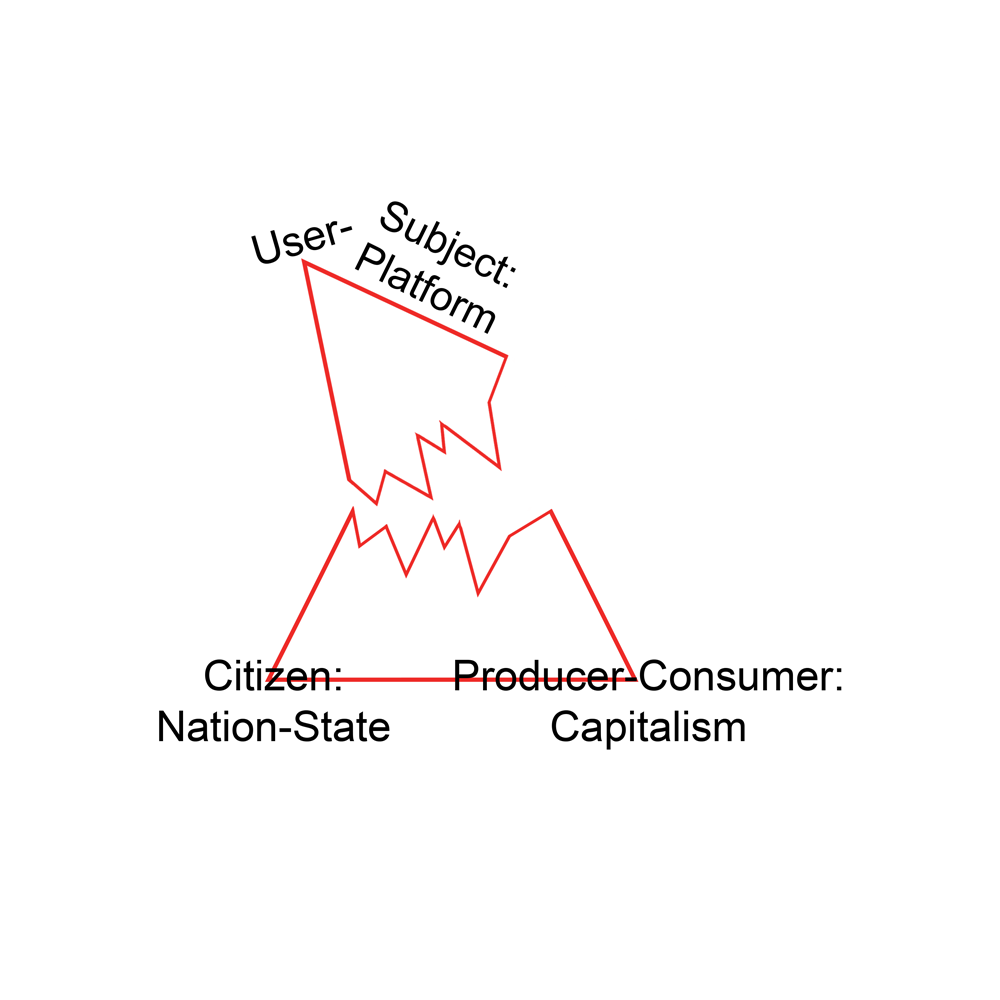
In the proliferation of computational technologies the user emerges as an increasingly necessary subject-position to traditional regimes of modernity/globalization. The notion of user is no longer a design or platform affordance, but a bio and geopolitical position. Benjamin Bratton's conceptualization of the User Layer put forward in The Stack: On Software and Sovereignty (2016) conceives of the user currently as an extension of traditional geopolitical systems (nation-state/economy). I’d like to use Bratton’s theoretical framework, which distinguishes the computational reality of the Stack from the felt experience of it, to further differentiate the tangible and ethical elements of user experience. I argue that when the management of multiple user identities and political positions within popular online platforms are treated as the normative politics of everyday life, it diffuses user agency by dissociating individuals from computational structures.1 It is crucial to reconceive being in relationship to the force of computation, unique to the contemporary moment’s technological affordances at local and planetary scale. I propose the idea of userscapes to help alternatively orient the user as an agent within an unfolding era of computation and infrastructure, rather than the subject of interface narratives.
Benjamin Bratton conceptualizes the User Layer as one of 6 layers in the Stack (Earth, Cloud, City, Address, Interface, User). The Stack is a design proposal to understand “…various species of contemporary computational technologies as … different genres of machines,” ranging from micro to meta in form and scale, as a coherent megastructure.2 The User Layer permits Bratton to separate the user as “a category of agents [rather than a type of creature] … a position within a system without which it has no role or essential identity,” from the user-subject, a specific mould shaped by an interface (the human as user-subject of a computer, or a profile on Facebook).3 Bratton’s proposal of the user and the Stack introduce useful concepts to understand the differences in operating in a computational infrastructure and being in a determined system (like a citizen to a nation-state, producer-consumer to an economy, or the human-controller of technological device). Bratton’s ideas can be further utilized to surface the unique affordances of being a computational user agent that are currently hidden in a gap between the user experience of the design proposal, and the computational reality of the Stack. In its current formation, the Stack reproduces users-as-subjects by keeping their vantage point of the technological metasystem, 6-layers thick, through the interfaces of popular platforms. Breaking the blinders of these column-parameters is necessary for any true political potential in entering in and out of the User Layer of the Stack.
Part 1. How the Stack hides and affords nontraditional geopolitical positioning
Where legal and governmental identification were once tied to analog record keeping systems, they now extend to digital user profiles as interfaces of technological systems. It is not so much that user accounts and profiles are interwoven into lives, but rather that social, political, and economic identities mandate user accounts and profiles. Instead of using a driver’s license as identity-validation to get a library card, many public institutions have adopted Gmail, Facebook, and Twitter accounts as standard profiles in their applications and services. Profiles are also used to validate each other interchangeably: a Facebook profile vouches for a user to create a SoundCloud account, in many cases mandating the sharing of personal, browsing data in exchange for the ability to interact with institutions and register for events.
But indeed these are subject-positions, which reinforce the image of a single and whole user as the subject of these pairings: may it be a device, such as a human-user to a smartphone, an online banking platform, such a user account to Chase bank, an environment, such as user to a city of ubiquitous computing, or a system, such as the user agent in the User Layer position of the Stack. These interfaces mould a user-subject which is not reducible to the agent(s) acting as users in the User Layer.
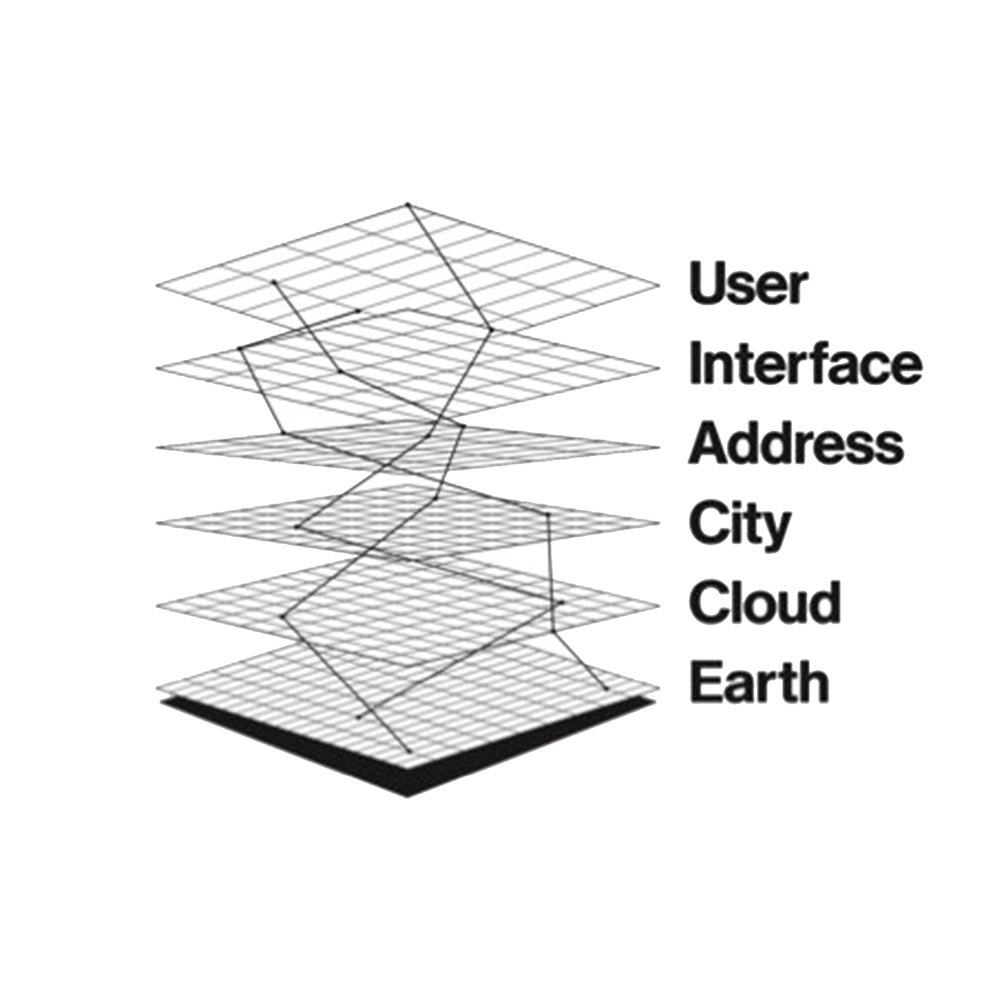
1.
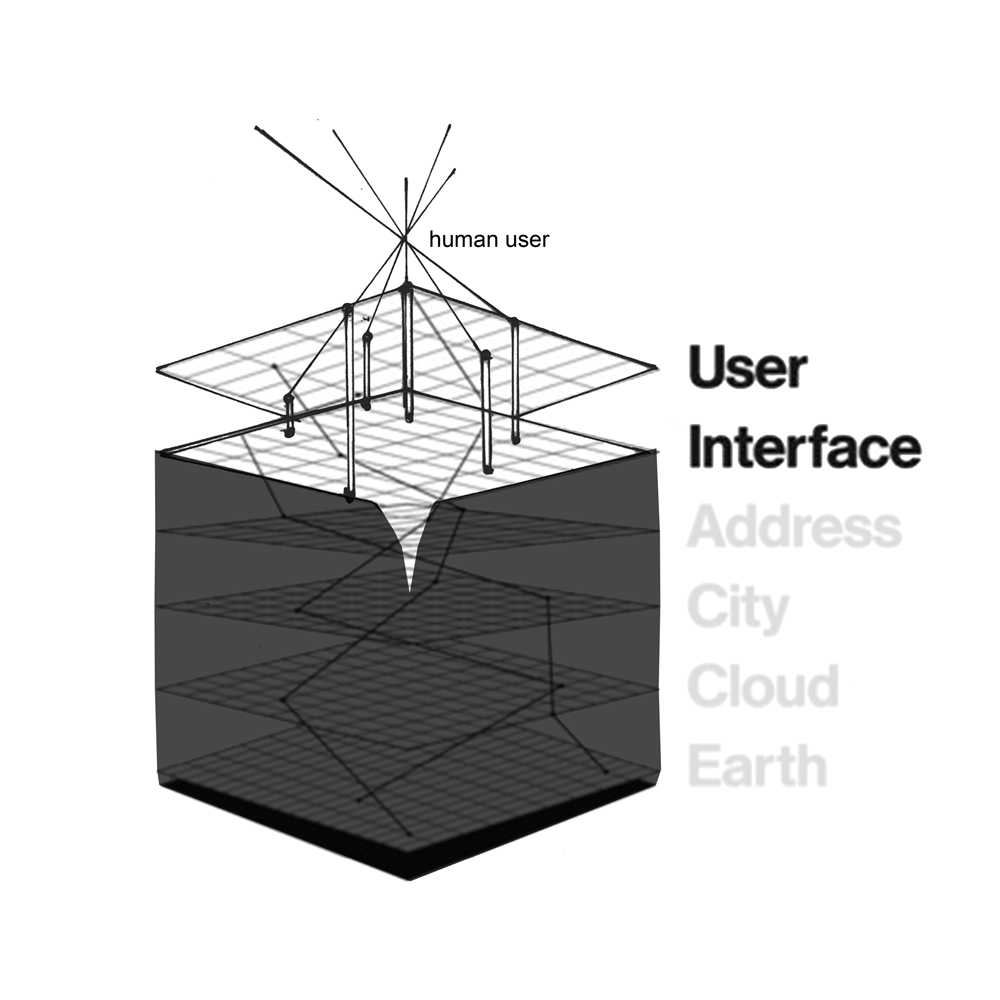
2.

3.
The full Stack vs. the user-subject’s experience of it
Left: Original diagram by Metahaven as published in Bratton’s The Stack: On Software and Sovereignty (2016)
Right: Diagram variations by G. Costello. Diagram of the Stack as represented 6-layers deep, multiple activations as “zigzagging” columns from top to bottom layer. These may be 3 different users–human or nonhuman, single or in composite; or the same user activating 3 different columns from 3 different positions, for example, sending a message from a smartphone, making a purchase on amazon from a laptop a minute later, and a daily steps goal being registered in a fitbit.
The first image above shows three column activations by a user agent that are both vertical and horizontal, as indicated by the zigzagging across the Layers of the Stack. Verticality indicates the up and down communication between platform layers in each activation. Horizontality indicates the infinite exchangeability of what may constitute, and be communicated to, in each platform layer as a module. As long as it can communicate in the computational language of the Layer, a Nest thermostat, bio-sensored leaf, or bot may step into a user position. This is the difference between closed systems like an assembly line or citizenship—in which there are set operations and laws for a set outcome/agreement, and open systems like an infrastructure and platform—in which there are a set of protocols for a process to occur by, where constituents may change without disturbing the process. Both horizontal and vertical movements, as connected to an open system, permit the movements of activations to change, like using your data plan to send a phone message vs. using a Wi-Fi connection. These may come from the same user agent, from two different user-positions, and activate two completely different columns in the Stack. This zigzagging is uniquely permitted by the Stack as it is modeled after an internet protocol suite, the Transmission Control Protocol (TCP) platform. In functioning within a common computational language the modular layers and their contents may interoperate and be altered without disrupting the Stack: this is the essence of its horizonality and verticality. It is a design for ongoing emergence, rather than a system for particular outcomes, because of the horizontal stacked modules. This computational horizontality makes interoperable different kinds of agents, agencies, temporalities, spatialities, and energies through an ongoing assembling. This is what makes acting as a user agent different than acting through the dualisms of citizen to nation-state and producer-consumer to economy.
The second and third images above are what the user-subject receives from the same activations: a collection of linear vertical activations between only the User and Interface Layers. The interface is the translation of computational infrastructure as an image of totality of the greater computational realm—both horizontally and vertically. Instead of thinking of the two different activations and different user positions made from sending a message via a data plan and Wi-Fi, it is more commonly experienced as the user-subject sending two messages through a phone, where two repeated actions appear in the same user-to-interface relation. One might think of graphical user interfaces (GUI) as fragments of the Stack. These fragments are used to make closed-loop narratives of computational infrastructure, that are neither narratives nor loops. For example, “What if a data object is originated in Beijing by a Japanese citizen, uploaded to a server off the shores of Vladivostok in international waters, and then used by a kid at an Internet café in Las Vegas to commit a crime in Brazil?”4 The kid in an internet café downloading the data object from Kickass torrent is one user-to-interface, closed loop narrative made from the full Stack activations and effects.
The current interface-to-user experience creates restrictive narratives that reinforce incorrectly that humans are the only kind of user agents, creating singular human bodies as satellites for the proliferation of disparate political and social platform identities and causing the affective absorption of personal responsibility and accountability, thereby reinforcing scenes of crisis. This is a design issue of truncated and closed-loop columns. The user-subject’s experience as a collection of linear user-to-interface columns of accounts and devices is a myopic scope of the computational platform reality. This myopic scope represents the colonization of technological computational force as afforded by the horizontality and verticality of the Stack Layers. When the user-subject is built into systems in this way, it limits the agency of the user to enact the system’s social and ecological potentials.
Where the user previously referenced a subject within certain parameters, it is now the head of differently-visible, systematic architectures that are not coherent in their legitimacy or accountability. What is not part of what Bratton calls a “poetic reflection” the user-subject sees in their popular platform profiles is that the “political interpolation of the User [in the Stack] never finally resolves into the biography of one single person in the same way that the identity of the citizen did and does.”5 Yet, users are advantageously exploited in marketing schema, ad-hoc legal cases, state surveillance, among other forms, as these architectures do not feed into an articulated accountable entity, institution, system, or territory. If the user-subject remains as a place marker for an entry within a dataset that can be mixed, matched, assembled, and disassembled, existing in extensive and complicated forms from the other side of the Interface Layer, there are dangerous political implications. This includes the further systematization of unethical practices through the constant shuffling of sovereignties, already consumed by administration and competing interests, and used to further confuse jurisdictions.
Part 2. Political dangers for user-subjects
Consider Facebook permitting the deactivation of Korryn Gaines’s Instagram and Facebook accounts during the attempted delivery of an arrest warrant by Baltimore police that led to her violent murder by the police. Facebook quickly shifted from being a site of live exposure of a civilian emergency by a state aggressor to instead granting an “emergency request” to the state. Such examples of state censorship reveal the socio-political inconsistencies of how the use of technologies as tools of self-protection is counteracted by other user rights given to state agents for their use as control mechanisms. For example, to some, being an internet user may mean neo-cyber-libertarianism for those permitted to a new digital republic–“If Bitcoin is money and Ethereum is law, Urbit is land,” while on the other hand, to others it may mean entering into an era of integrated planetary-capitalism, where the idea of access to a market entity is considered a human right in projects striving to “[Bring] the internet to the farthest corners of the earth,” like Facebook Zero.6
While relationships between the state and corporations are not new, the dangers of their morphing into something even more untenable are held strong by the Stack’s single Interface Layer. As interfaces “reduce operational possibilities of code, compressing them to a set of predetermined choices,” it is necessary to design them both horizontally and vertically, in multiplicities and in intertwinement.7 More horizontal interfaces may give new political subjectivity to the at-once local, global, and intersectional scenes of the user as an agent. This would help orient the user agent in operating in open systems rather than closed-loop narratives.8 In this horizontal and vertical arena, scenes indicate different yet possibly simultaneous activations that may take different shapes. The scenes of user agents are amorphous, and not anchored to false extensions of accountability and legitimacy currently embodied in bundles of user-subject-to-interface as truncated and closed columns. Opening the horizontality of the Layers into the felt user experience may permit a closer connection between the user and the constantly evolving realm(s) of their scenes, as computational data forms, in the both horizontality and verticality of the 6 Layers of the Stack. The user may be able to see past the positions they are subjected to and their amorphous manifestations in a variety of activations that are not together loyal to particular systems.
Political identities in their many inequalities bleed through user-profiles. But user agency suffers when it is determined through the image of user-subject activated columns, which keep blinders on human users and continues the conception the world through popular graphical user interface (GUI) regimes and technological devices. In news debates of the use of technology that created the circumstances of Korryn Gaines’ murder, a NPR newscaster projected that “social media is not a legal right, yet.”9 In light of the breadth of surveillance systems, from on-the-ground with cameras embedded into police uniforms and citizen recording, to wide-area surveillance like the private company Persistent Surveillance Systems, the user moves beyond a determination by scattered platforms, devices, profiles, and locations into a collective cross-platform identity surveilled by the state and corporations, even when privacy measures like cryptography might be used.
As profiles form access to global infrastructure, there are dangerous political implications. Considering the campaign rhetoric of Trump is now actionable in his newly received presidential position, and that cyberspace is a site for necessary defense (against cyber attacks and terrorism surveillance, among other things), it is hard not to imagine scenarios in which social media, the internet, and according profiles are increasingly imagined as legal requirements to access common resources, and necessary to participate in government, society, and daily life. Such measures could unproportionately effect undocumented immigrants, who have had long-standing difficulty in or impossibility of working legally and getting national identification cards, meanwhile they are increasingly asked for identification for profiling. The further development of these troublesome measures within the infrastructure of the Stack is likely to draw from the existing infrastructure of current subject-to-interface standards. The monitoring and restriction of access to computational global infrastructure of non-citizens, or other politically marginalized users, would displace subjects from the Stack infrastructure as an agnostic global system and the resources it coordinates. The issue of not seeing beyond isolated collections of user-to-interface narratives needs to be considered within larger scales than social media and retargeting ads. Usership also extends to the future of human resource management and productivity tracking, including growing experimental measures such as employment performance and biotracking. Speculating further, user registers may be part of future determinations to commodity flows, and the distribution and pricing of basic resources and services like electricity, water, gas, and internet and groceries; as well as transportation systems like subways, highways, sidewalks, and even employment reviews and ratings for goods or services received like pharmaceuticals and healthcare services. Within these new user-subject positions lies the possible refusal of legitimate recognition from unaccountable, yet gatekeeping, powers to such world and life-securing resources. New kinds of displacement of being are being forged.
Part 3: Userscapes
The Stack is increasingly integral to the functioning of global power regimes.10 The question is: how to reveal more agential potentials for computation through the Stack outside of the regimes that have brought it to fore? Thinking through such questions can allow us to image what agency might look like without traditional closed parameters of nation-states and commercial blocks. In connecting agency to the capacity of computation beyond its technological applications we can rethink how global systems orchestrate being. The Stack, as a computational infrastructure made of modules, permits logic and interoperation at the ecologic, political, and social levels.
In the beginning of the chapter titled “Earth Layer” in The Stack, Bratton underscores that computation is a force, not a human invention, and that the Stack is just one of the ways it is captured through technology.11 Computation is a force, where the the various positions and relations of the human to it crosses discourses, disciplines, and cultures alike. Human geographer Kathryn Yusoff by way of Roger Caillois elaborates on the notion of computational agency:
If geology is sensible of itself in so much as it has an ordering logic, if it is articulate in its stratifications, reading pebbles, rocks, various kinds of matter, sorting, organizing (Roger Caillois calls this agency ‘computational’), folding, compacting the biological slime of the earth into its various layers.12
The concept of userscapes is helpful to understand agency as a constantly morphing constitution that is inherently intersectional, and temporally, spatially indefinite, as a way to situate being a user in an open-ended, horizontal and vertical, computational system. An understanding of ongoing Stack activations as userscapes may help us conceptualize the user as a force of computation, as channeled through technology. Moving forward, the introduction of the conceptual project of The Stack and userscapes aids in the project of rethinking political and economic systems from a vantage point that is neither bottom–up or top–down. The orientation of a computational user agent, activating horizontal and vertical columns, that may be seen in groups and simultaneous layers as userscapes, may be more like 3-D thinking. This may make-felt the full verticality of activations of computational platform systems.

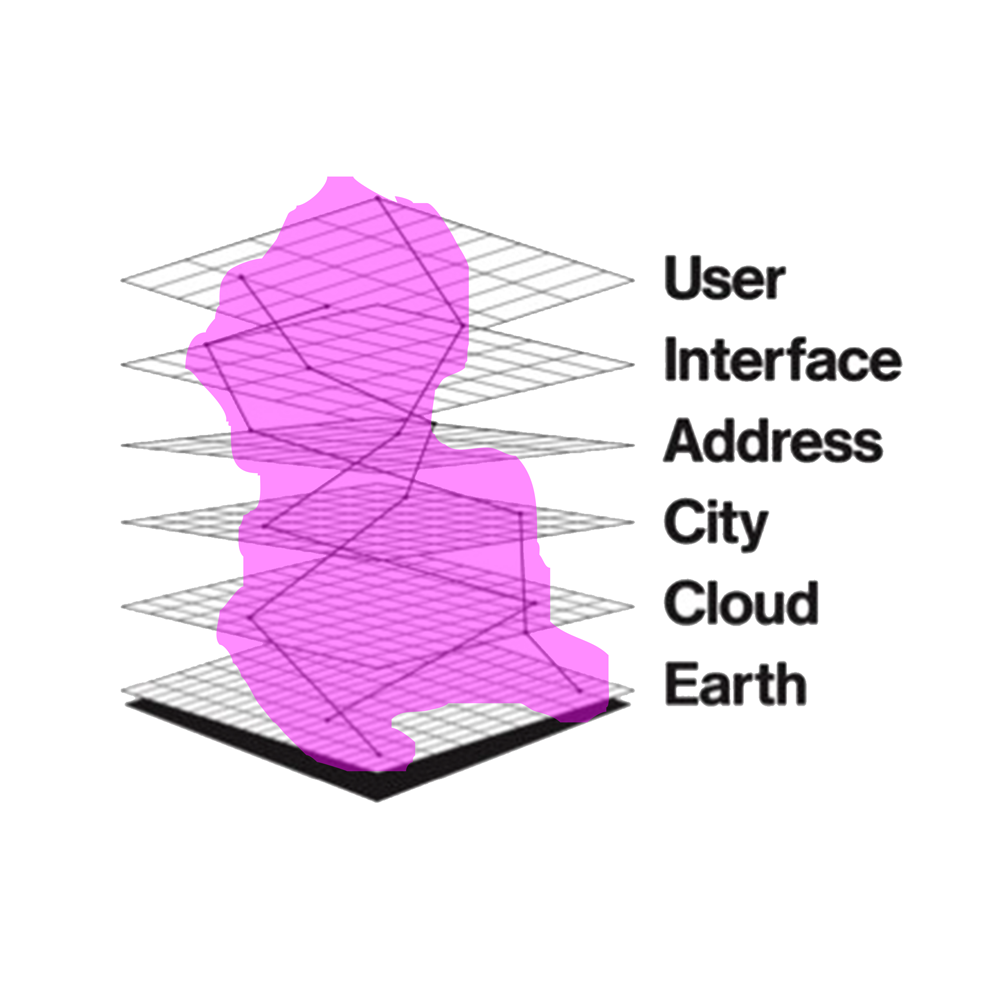
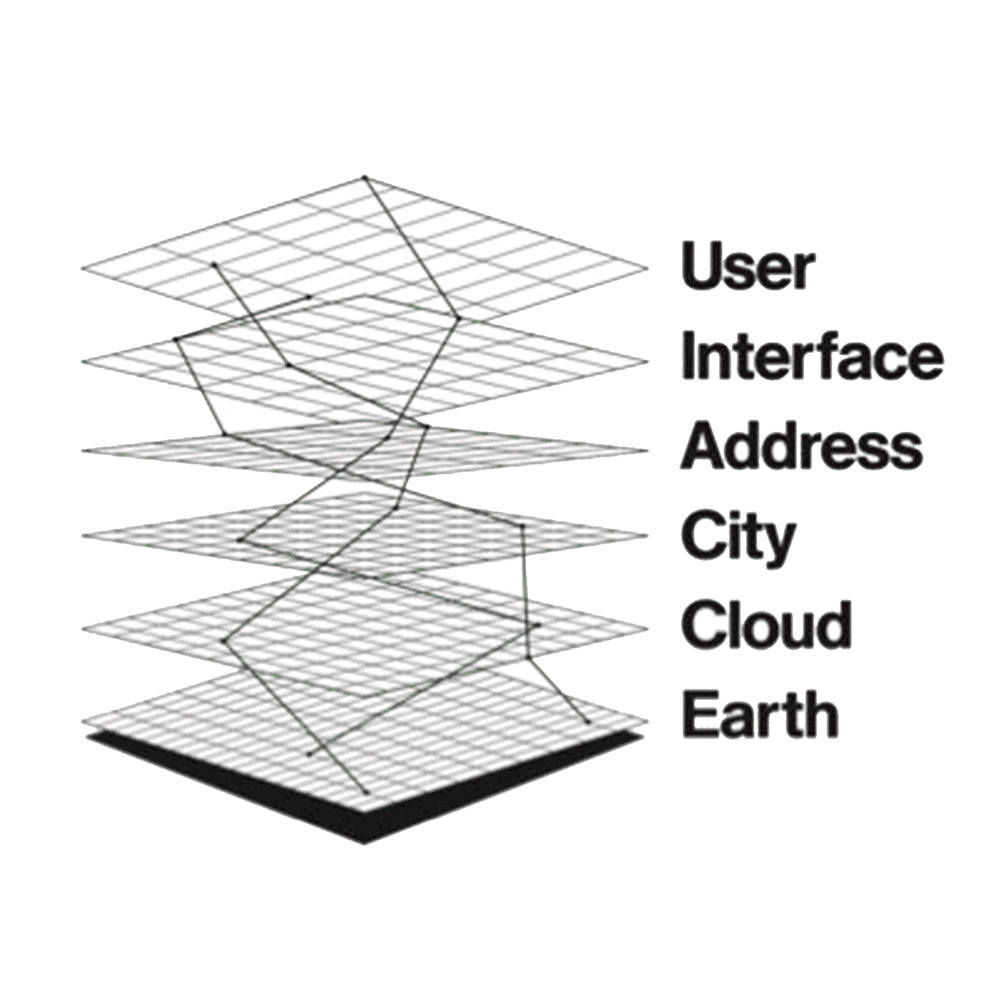
Horizontally infinite: scapes based on movements and clusters of sites rather than predetermined positions and routes.
As an exercise to thinking about what a userscape means, let’s read these 3 different column activations linked to one user in one day, acting alone or in combination with other types of user agents. These activations may be seen as a cluster– as forming one kind of “scape” that is both horizontally infinite–as it may include taking any position in the User Layer, and is 6-layers deep. In any range of activations, many scapes may at once take shape. They may overlay and absorb through each other or be in contest. Userscapes make references to the different user positions in motion, visualizing that user agents are not one user-subject with one position from which agency emanates. Accountability and responsibility do not rest on a single user across different columns, but are horizontally and compositely weighted in the horizontality and verticality of the Stack. In this case, specificities of both agency and governance are not consistent but emerging. Userscapes are based on ongoing, changing parameters by way of technological computation. They reorient being within changing sites, actions, and intersections. In doing so, userscapes alleviate the user the weight of false determinate platform identities, reveal sites and movements of possible accountability with both locally and globally attribution, and unite the user as a being within sets of ongoing infrastructural, open loops.
In the necessary long-term thinking of geodesign for a new computational paradigm in the wake of ecological crisis, there must simultaneously be a bridge to the current inequalities of users-made-subjects at stake in current socio-political formulations. In some ways, the contemporary moment feels like a race to realizing the potential of “the design of the terms and norms of that irresolvable multiplicity [of the user that] is inseparable from the design of the sovereign characteristics of the Stack layers that mediate it …”13 This potential lies in moving beyond the reproduction of nation-state and economic subjectivities in the Stack that further embed not only the lack of social and ethical conditions in the orchestration of life, but crisis in their disjunctures: anomie in the Interface Layer. Userscapes help create an experience of being an indeterminate user activating, and in operation with, the full scope of the Stack–from user to earth. We must maneuver from traditional concepts of rights and agency, which cannot be simply verticalized to being a user within the mode of computational affordance, which lies in the horizontonality of the Stack’s platform layers.
The concept of userscapes can help elucidate an understanding of what it means to “be” in the infrastructure of the computational sphere. Bratton’s notion of the Stack, presents the potential for a new paradigm of ecosophical evolution, as Félix Guattari forecasted via influence of Gregory Bateson in The Three Ecologies: “the ethico-political articulation between three ecological registers...the environment, social relations, and human subjectivity.”14 Userscapes may help unfold an entrance to being not tethered to the interface of a platform, which remains in “the simplistic state-versus-market metaphysics of mainstream Silicon Valley technolibertarianism … undersells the disruptive potential of its own product [the Stack].”15 As Guattari articulates, the emergence of social media as web 2.0 marked the development of a new kind of connectivity of being, space, and power as a new phase of integrated world capitalism. Integrating the horizontality of the Stack’s platform layers, as the realm of interoperativity permitted by computation, into user interfaces may make felt the user’s full Stack activations. This has the potential for new ecologies of user as an earth and planetary agent, and interoperable agency within global power regimes for a new computational paradigm.
-
Bratton, The Stack: On Software and Sovereignty, 314 ↩︎
-
Bratton, “The Black Stack.” ↩︎
-
Bratton, The Stack: On Software and Sovereignty, 251. ↩︎
-
Bratton, The Stack: On Software and Sovereignty, 113-4. ↩︎
-
Bratton, The Stack: On Software and Sovereignty, 314. ↩︎
-
It is worthy to note that the name of the Internet-delivering drone, Aquila, means eagle in Italian and is often used as a symbol of power by the state and military since ancient Rome. ↩︎
-
Bratton, The New Centre. ↩︎
-
Considering the combined developments of globalization, mass immigration, and electronic media, what makes a locality is “…now primarily relational and contextual rather than scalar or spatial,” argues anthropologist Arjun Appadurai in The Production of Locality (178). ↩︎
-
Kaste, "Groups Worry About Impact Of Police Moves To Block Social Media," emphasis my own. ↩︎
-
Rather than non-world-dominating heterogeneous pockets of culture or the geologic and biologic. ↩︎
-
Bratton, The Stack: On Software and Sovereignty, 75-81. ↩︎
-
Yusoff, “Anthropogenesis: Origins and Endings in the Anthropocene,” 19 ↩︎
-
Bratton, The Stack: On Software and Sovereignty, 314 ↩︎
-
Guattari, The Three Ecologies, 20. ↩︎
-
Bratton, The Stack: On Software and Sovereignty, 314 ↩︎
Bibliography
Bratton, Benjamin. "The Black Stack." E-flux 53 (2014): n. pag. Mar. 2014. Web.
Bratton, Benjamin. The Stack: On Software and Sovereignty. N.p.: MIT, n.d. Print.
Bratton, Benjamin. "The Stack to Come: Synthetic Sensing/Intelligence (and The New Normal)." Class Lecture/Discussion. The New Centre for Research & Practice, Google Hangouts. Nov. 2016. Lecture.
Guattari, Félix, Paul Sutton, and Ian Pindar. The Three Ecologies. London: Athlone, 2000. Print.
Kaste, Martin. "Groups Worry About Impact Of Police Moves To Block Social Media." Morning Edition. NPR. Social Web, New York, New York, 30 Aug. 2016. NPR.org. Web.
Yusoff, K. "Anthropogenesis: Origins and Endings in the Anthropocene." Theory, Culture & Society 33.2 (2015): 3-28. Web.
Genevieve Costello is a researcher in technology and culture and experimenter in space, form, and the body based in Amsterdam. Her writing has been dedicated to exploring what it is to become-user as a philosophical and political reorientation in the proliferation of immaterial data infrastructures. Currently, she is developing an educational web series that uses fashion and fantasy to engage speculative futures, cultural theory, and feminism for children.